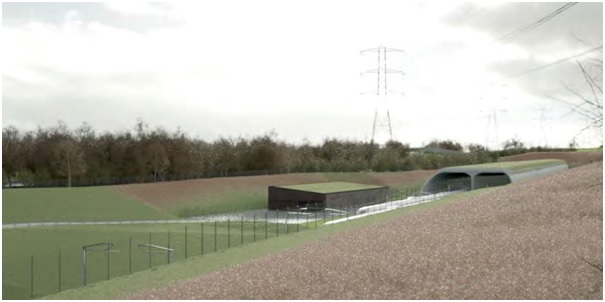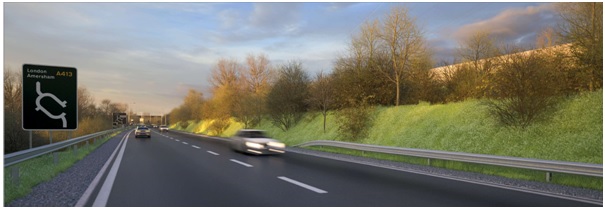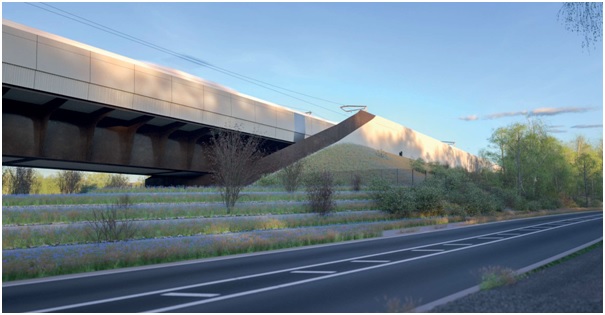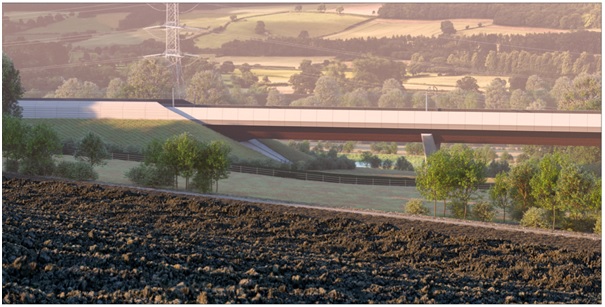Issues - Noise

Noise from trains was identified as a problem issue when the original HS2 plans were made public. As part of the House of Commons approval process HS2 gave assurances on mitigation of the noise impact experienced at residential locations.
Since approval of the "Engineering Reference Design" embedded in the Act in 2016 we have been engaging with HS2 Ltd, EKFB (the Civil Engineering Contractor building the Wendover section of the line), and Buckinghamshire Council. While the detailed designs approved for construction show some improvement over the 2016 plans, it is now clear that progress is still needed on the three key issues that we identified as our current predictions are that the noise will be excessive.
The three issues that we are working on are:
- The trains will be noisier than we expected.
- It will be very difficult to get this sorted after the design of the line is agreed by Buckinghamshire Council.
- We have noise mitigation options that could be included.
So what has gone wrong? We have identified three factors (click on the hyperlinks below to see the detail we have compiled on each of the individual issues).
- The HS2 noise estimates were wrong to start with as the noise 'model' they used produced inaccurate results.
- The specification for the trains that are actually going to be used is 'noisier' than the original 'HS2 train' proposed for use between London and Birmingham.
- They have changed the type of track they intend to use to lay preformed sections, this is called a slab track - this is potentially noisier than the type originally planned.
These three factors combined mean that they will find it increasingly difficult to keep to the promised levels, in fact the noise that will be produced exceeds the World Health Organisation night time limits of 60db which will impact many residents trying to sleep, and shatter the peace of Wendover. We think it's in everyone's interests to address how we can ensure that additional mitigation will become available in future, as HS2’s policies mean that it will become very difficult to sort this out later.
The problem also is that it's not just an occasional noise, about 36 trains per hour are scheduled to run during the daytime and 60 in total at night, so is a continual impact on daily life.
We have done a number of 'technical reports' about this issue that we have used in discussions with people involved which you can read (see Documents in the main menu above).
In order to deal with this problem HS2’s process involves documentation of "indicative mitigation" in a Noise Demonstration Report (NDR) that accompanies the Schedule 17(3) design documentation submitted to the Council. The NDR is subject to pre-submission discussion with the Council’s Environmental Health Officers to determine if the noise will be reduced "as far as reasonably practicable". This approval is based on a set of assumptions and modelling predictions, but the true situation will only become apparent when the line has been built and test trains are able to run on the tracks.
The Council will be involved in the future agreement of the actual noise mitigation as part of the Schedule 17(9) Bringing into Use approvals. Design changes could be considered if the noise is determined as being excessive. Our contention with this is the current lack of detailed definition of the Noise Measurement and Assessment methodology.
If it is deemed that the noise is excessive there seem to be three possible options to be considered:
- To provide additional noise barriers if there is a case for these to be reasonably practicable. Our contention with this is the commercial Cost/Benefit assessment currently used by HS2 which does not adequately consider the Peak noise criteria in the Act. The Contractor is not incentivised to meet the target levels in the Act and can "reasonably" disqualify any additional mitigation on cost grounds.
- To slow down the trains. The whole point of HS2 is that it is 'High Speed' and the historic position of the Government has been not to slow the trains down. In 2023 the Government’s whole High Speed Rail strategy is being reviewed, and there is scope for a speed reduction which could reduce the Construction costs of the line and the trains. There would also be an Environmental improvement in the reduction in the amount of energy required to operate the trains.
- To do nothing and expect us to just live with it. With the delay in building the Euston terminal the maximum possible number of trains per hour will be reduced as a result of the limited number of platforms available at Old Oak Common and time needed to allow passengers to get off and on the trains. HS2 could also operate a more infrequent initial service which would further reduce the number of trains passing Wendover. Once the community "gets used to the noise" the number of trains could be increased in future years without significant adverse reaction.
Noise mitigation proposals
During the detailed design stage the impact of various system changes were taken into account, including the removal of figures for the European standard "TSI" trains (as there is no longer a connection to the Channel Tunnel) and a general reduction of the spacing between the tracks. The use of noise "bund" earthworks and barriers were reviewed, and changes made to the design previously agreed in the Act. The contractors were required to attempt to reduce excessive noise impacts "as far as reasonably practicable" which precluded any significant investment. In North Wendover we are concerned about the section of the track north of the Green Tunnel, where the railway emerges into the Wendover North Cutting. Details can be found in the "Nash Lee" Noise Demonstration report.
At Nash Lee Lane a 3m high noise barrier has been replaced by earthworks which improves the visual impact in the AONB. The number of houses over the 60dB limit has been reduced from 45 to 42.

Immediately north of the Green Tunnel the landform of the cutting has been changed with steeper sides which will reduce the number of houses in excess of the 60dB limit near Dobbins Lane, Bridleways, and Lionel Avenue from 306 to 228. Our modelling of additional mitigation options with trackside noise barriers showed further improvements as being possible, but were generally rejected on cost and visual impact grounds. We identified the critical issue as noise gets round the portal building at the tunnel mouth, and EKFB agreed to consider filling in the gaps with barriers in future.
South of the Green Tunnel the details are given in the "Small Dean" Noise Demonstration report.

A 6 metre high noise barrier was originally proposed, but this has now been reduced to 5m. This reduces the number of affected houses near South Street and Hale Road from 181 to 120. A further reduction to 113 could be obtained by keeping this barrier 6m high, but that benefit was overshadowed by the visual impact improvement and cost reduction available from the lower height barrier. The slope of the embankment has also been increased to allow the inclusion of a bund to hide the lower part of the barrier as seen from the bypass. The Western side of the embankment is unchanged with a 4m high barrier and 5 properties in Bacombe Lane still affected.
On the viaduct itself the parapets have been raised from 1.4m to 1.85m, but this has little acoustic benefit for residents. The Small Dean South Embankment between the viaduct and Rocky Lane still has 3m high barriers on each side with 63 properties near London Road and Kings Ash continuing to be over the limits.

Further south the Wendover Dean Viaduct parapets again form noise barriers, and the embankments at each end of the viaduct will have 2m high noise barriers on east and west sides before the line enters the Rocky Lane and South Heath cuttings. 23 properties will still be over the limits compared with 32 in the original design. The details are given in the "Bowood Lane" Noise Demonstration report.
